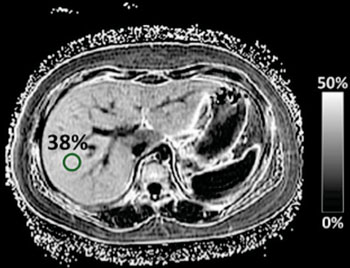Researchers Develop Technique for Noninvasive Diagnosis of Non-Alcoholic Fatty Liver Disease in Children
By MedImaging International staff writers
Posted on 15 Feb 2015
Non-Alcoholic Fatty Liver Disease occurs when large droplets of fat are deposited in the liver. NAFLD is related to insulin resistance, and risk factors include obesity and diabetes. Posted on 15 Feb 2015
Currently, NAFLD is diagnosed by specialists, who carry out a biopsy of liver tissue and examine it under a microscope. Diagnosis is graded by pathologists based on the extent off steatosis in liver cells. NAFLD is common in children in the United States (US) and the Western World and can lead to hepatitis, cirrhosis, scars in liver tissue, and liver cancer. Most cases are never diagnosed.

Image: MRI of severe NAFLD in a child\'s liver with 38% fat (1% is normal) (Photo courtesy of UCSD).
Now researchers at the University of California, San Diego (UCSD; San Diego, California, USA) School of Medicine have developed a noninvasive technique to detect NAFLD, using magnitude-based Magnetic Resonance Imaging (MRI). The researchers compared standard liver biopsy with the MRI technique to estimate Liver Proton Density Fat Fraction (PDFF) in 174 children. They found a significant link between liver fat determined by pathology, and that measured by the new MRI technique. The new method correctly classified the presence of fatty liver tissue in 65%–90% of the children.
Jeffrey B. Schwimmer, MD, professor of clinical pediatrics at UC San Diego said, “A noninvasive method for diagnosing and/or evaluating NAFLD has the potential to impact millions of children. We are especially excited about the promise of the technology for following children with NAFLD over time. However, further refinements will be needed before this or any other MRI technique can be used to diagnose NAFLD in an individual child.”
Related Links:
UCSD














